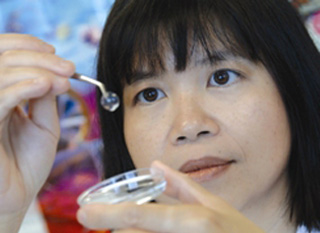
Diseases which cause clouding of the cornea pave a path to the most common cause of blindness. For a long time experts have been developing biosynthetic corneas with the help of collagen formed in the laboratory and are further carved into the shape of a cornea. After thorough analysis scientists have put forth in-human experience with biosynthetic cornea implantation.
“This study is important because it is the first to show that an artificially fabricated cornea can integrate with the human eye and stimulate regeneration. With further research, this approach could help restore sight to millions of people who are waiting for a donated human cornea for transplantation,†said senior author Dr. May Griffith of the Ottawa Hospital Research Institute, the University of Ottawa and Linköping University.
Experts conducted a clinical trial among 10 Swedish patients with advanced keratoconus or central corneal scarring. Every participant enlisted for the study underwent surgery on one eye to eradicate damaged corneal tissue and restore it with biosynthetic cornea. This cornea was developed using synthetically cross-linked recombinant human collagen. After prolonged analysis, the scientists evaluated that cells and nerves from the patients’ own corneas had developed into the implant. This caused formation of a regenerated cornea that resembled normal and healthy tissue.
“We are very encouraged by these results and by the great potential of biosynthetic corneas,†remarked Dr. Per Fagerholm, an eye surgeon at Linköping University in Sweden. “Further biomaterial enhancements and modifications to the surgical technique are ongoing, and new studies are being planned that will extend the use of the biosynthetic cornea to a wider range of sight-threatening conditions requiring transplantation.â€
Experts were surprised to identify that the participants did not experience any rejection reaction or require long-term immune suppression. These conditions are observed to be extreme side effects linked with the use of human donor tissue. The biosynthetic corneas became sensitive to touch and started producing normal tears, thereby keeping the eye oxygenated. Among the participants enlisted for the study, six out of ten experienced advanced visions. Besides, after contact lenses were fitted, vision was similar to conventional corneal transplantation with human donor tissue.
These findings were published in the August 25th, 2010 issue of Science Translational Medicine.
